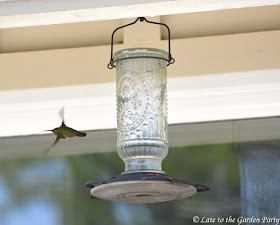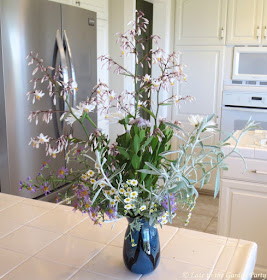I'm joining Loree of
danger garden in recognizing my favorite plants this month. I can't see the foliage for the flowers right now so perhaps it's not surprising that all my current favorites are in flower, even if at least some of them were originally planted specifically for their foliage.
Achillea 'Moonshine' began blooming at the start of the month and it's in full flower now. It has a long bloom period. Last year, it bloomed from the latter part of April until mid-September. It's sunny presence dominates my back garden at the moment.
 |
| When we removed the last of our back lawn in 2015 and laid a flagstone path between wide borders on either side, I planted 'Moonshine' on both sides to tie the areas together visually |
The next plant,
Arthropodium cirratum, commonly known as Renga Lily, is my go-to favorite for dry shade. I purchased my first plant in January 2011 by mail order and added more later the same year. In January 2012, I even added 3 plants to my neglected back slope. They survived there and even bloomed but, when the removal of the giant
Yucca elephantipes made the area much sunnier, I pulled the plants, divided them, and replanted them in shadier locations. Within 2 years, they form large clumps and dividing them is relatively easy. The last time I did so, I had not only enough plants to fill another area newly cleared of lawn but also enough to give to a friend and a next door neighbor. And, with still more plants left over, I placed the bulb divisions in buckets along the street (with a plant description) to be taken by anyone who walked by. They need periodic dividing as they otherwise get huge and baiting for snails is essential.
 |
| The evergreen clumps are attractive year round but I also love the tall flower sprays they produce this time of year |
I planted 3
Centaurea 'Silver Feather' in March 2015 for the foliage. I considered that the pinkish purple flowers mentioned on the tag would be a bonus. My plants didn't bloom in 2015 or 2016 and I'd pretty much given up on their doing so until the first flowers appeared earlier this month. According to the tag, the plant was supposed to grow about 16 inches tall and 12 inches wide and I planted based on those dimensions; however, even after hacking the plants back this winter, they're closer to 30 inches tall and wide. In colder climates, I understand that they'll die back over winter but here the plants are ever-silver.
 |
| The plants weren't intended to block the flagstone path. I may try moving them this fall. |
Dorycnium hirsutum (aka Hairy Canary Clover), another silver-gray plant I introduced for the foliage, is also in bloom at the moment. It self-seeds freely here and, although the seedlings can be touchy about being transplanted, I've managed to spread it through several areas of the garden. It stays low and makes a good weed-suppressing ground cover.
 |
| The foliage is soft and fuzzy to the touch. The bees love the clover-like pink and white flowers. |
 |
| A self-seeded Dorycnium is shown here next to succulent Oscularia deltoides, making a pretty in pink combination |
Another pink-flowered plant that surprised me with recent blooms is
Echinopsis oxygona. A gift from a friend, I thought I'd missed out on the flowers this year but 2 more flowers appeared this week. I'm thinking of giving the plant a chance to live outside its pot but I'm dreading the transplant process.
 |
| At some peril, I managed to remove the weed in this pot |
I included
Euphorbia 'Dean's Hybrid' in this month's favorites post principally because it just looked so good backlit on the back slope paired with
Agave attenuata. I've cut back most of the flowering plants on the slope so there's not a lot of color there at the moment but
'Dean's Hybrid' adds a nice glow to the space.
 |
| 'Dean's Hybrid' has grown on the dry back slope for 5 years now. It dies out here and there but gently spreads itself around, always forming nice big clumps of chartreuse color. |
Believe it or not, I also bought
Globularia x indubia for its foliage. I liked the thick, almost succulent leaves. I'd never heard of the plant when I picked it up at a local botanic garden sale in 2012. Its blue and white flowers were a surprise. It's been slow to beef up but, like so many plants in my garden, I think this past winter's heavier-than-usual rains gave it a major boost.
 |
| I fondly refer to this as my hairy blue eyed plant |
My next favorite,
Jacaranda 'Bonsai Blue', is a relatively new acquisition. I picked it up as a Christmas present to myself late last year, after giving up the hope that its price would come down. Living in Southern California, you can't help but fall in love with
Jacarandas. They're common here and, despite being one of the messiest trees around, are frequently used as street trees. Regardless of their messy ways, they're gorgeous when in bloom; however, the common form can grow 40 feet tall, which creates an issue in my community if it's planted anywhere that might interfere with a neighbor's view.
'Bonsai Blue' is a dwarf. The tag said it grows just 6 feet tall but other sources claim it can get 10 feet tall. Even so, that's under the limit specified by my community's "view conservation" ordinance.
 |
| At present, my 'Bonsai Blue' is just over 2 feet tall |
Some people consider Shasta daisies,
Leucanthemum x superbum, common but I love them. I have a ruffled form, sold without a cultivar name. They flower on roughly the same schedule as
Achillea 'Moonshine', although they don't have quite as long a bloom period. Their petals are such a bright white I found them hard to photograph even under cloudy skies.
 |
| The plants do best here with some light shade during the hottest part of the day |
The small white flowers of
Tanacetum niveum were easier to photograph. Like the larger Shasta daisies, they add a sparkle and freshness to the garden.
 |
| The flowers look like those on the common feverfew but the foliage is a soft gray color. The plant is moderately drought tolerant. |
I'll close with a mash-up of 3 evergreen vines that flower in unison at this time of year:
Pandorea jasminoides, Trachelospermum jasminoides, and
Pelargonium peltatum. Although these are relatively common plants, at least here, their combination is somewhat unexpected. The white bower vine and star jasmine were in place when we moved in. I added the dark pinkish-red
Pelargonium, which I'd brought with me from my former garden. I hadn't intended to have it climb the arbor to join the other 2 plants but it had aspirations and took off on its own 2 years ago.
 |
| The only problem with this mash-up is the difficulty in keeping it trimmed. I'm going to have to get a ladder out to cut it back this year. |
Visit Loree at danger garden for a look at what she and other gardeners are favoring this month.
All material © 2012-2017 by Kris Peterson for Late to the Garden Party































































